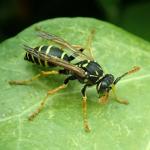Polistes nimpha is a primitively eusocial species with poorly-differentiated queens,
Added to the British mainland list by Falk and George 2021 (Falk, S.J. and George, S. 2021. Polistes nimpha (Hymenoptera: Vespidae) Another Paper Wasp New to Britain. British Journal of Entomology and Natural History. 34: 1.
Download the paper adding Polistes nimpha to the British list below:
Warwickshire and Jersey
Europe north to S. Finland, Palaearctic Asia east to Mongolia, China, and Russia Far East.
A useful key is available in Falk and George 2021
Prefers open habitat. Avoids heavily wooded areas.
In Poland P. nimpha emerges and starts to build nests from April until early May. Colonies begin to disintegrate in late summer following emergence of males and decline throughout autumn.
The foundresses usually build nests at a height of 10-20 cm above ground. These can be attached to assorted herbaceous plants (including grasses), dwarf shrubs such as heather Calluna vulgaris, thickets of shrubs and Rubus spp., young trees, and reed beds of Phragmites australis. The nest is attached by a more or less horizontal petiole so that the comb faces to the east and can warm up more rapidly in the morning sun. The nests comprise a single spherical comb constructed of wood pulp, as in vespine wasps, but there is no outer insulating envelope around the comb. Nesting can also be associated with man-made structures such as eaves of buildings or attics. Colonies on natural vegetation are usually haplometric (i.e. founded by a single queen), while some of the colonies associated with buildings are pleometric (i.e. with two or more queens assisting each other) (Cervo & Turillazzi 1985; Rusina et at, 2007). Young nests are prone to predation by badgers, foxes and ants but this lessens as workers establish and defend the nests (Kozyra & Baraniak, 2016). Colonies do not normally exceed a few dozen individuals.
2021


